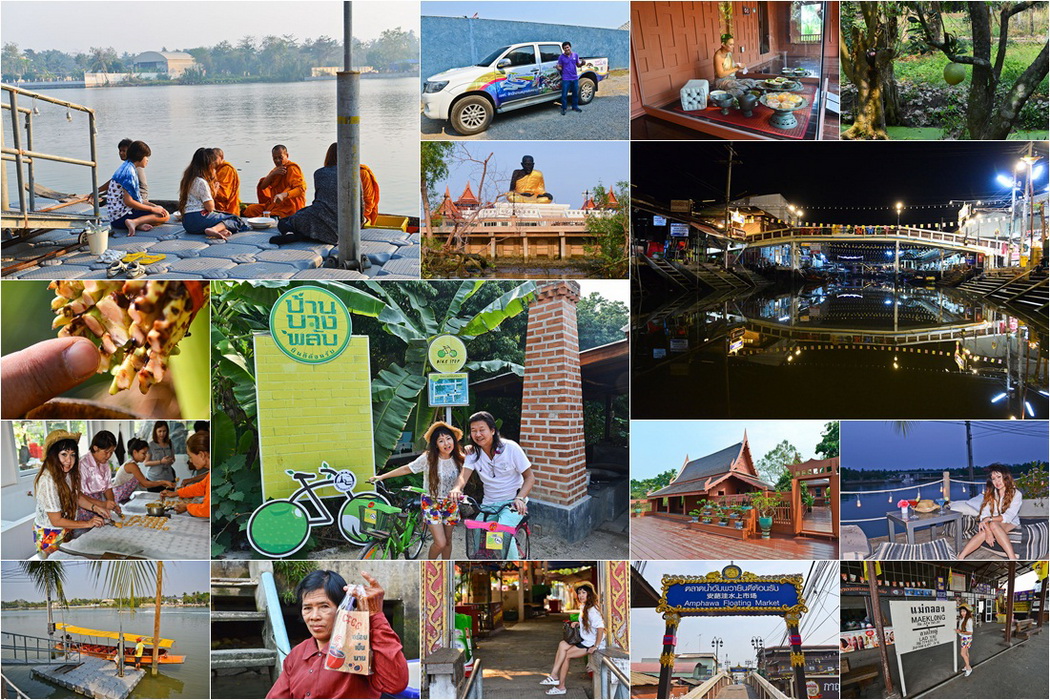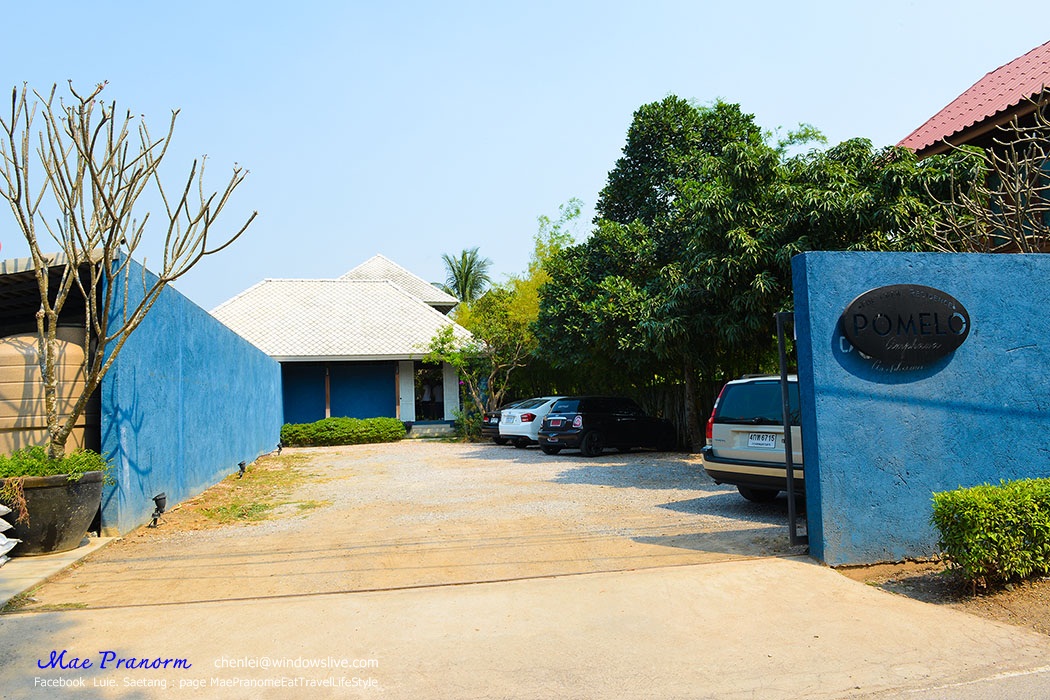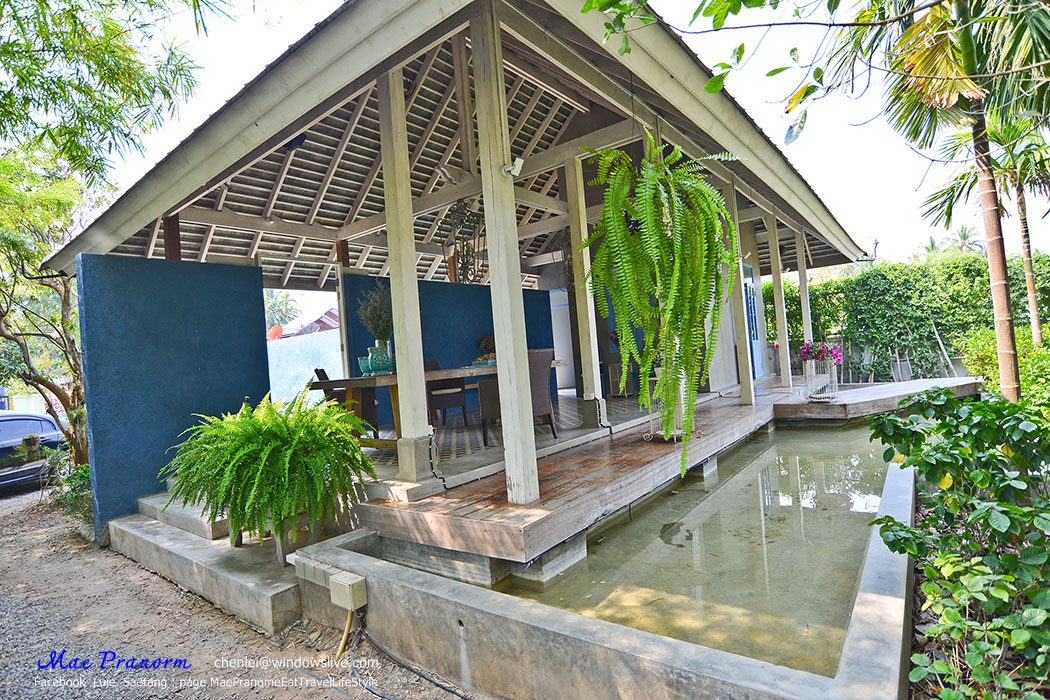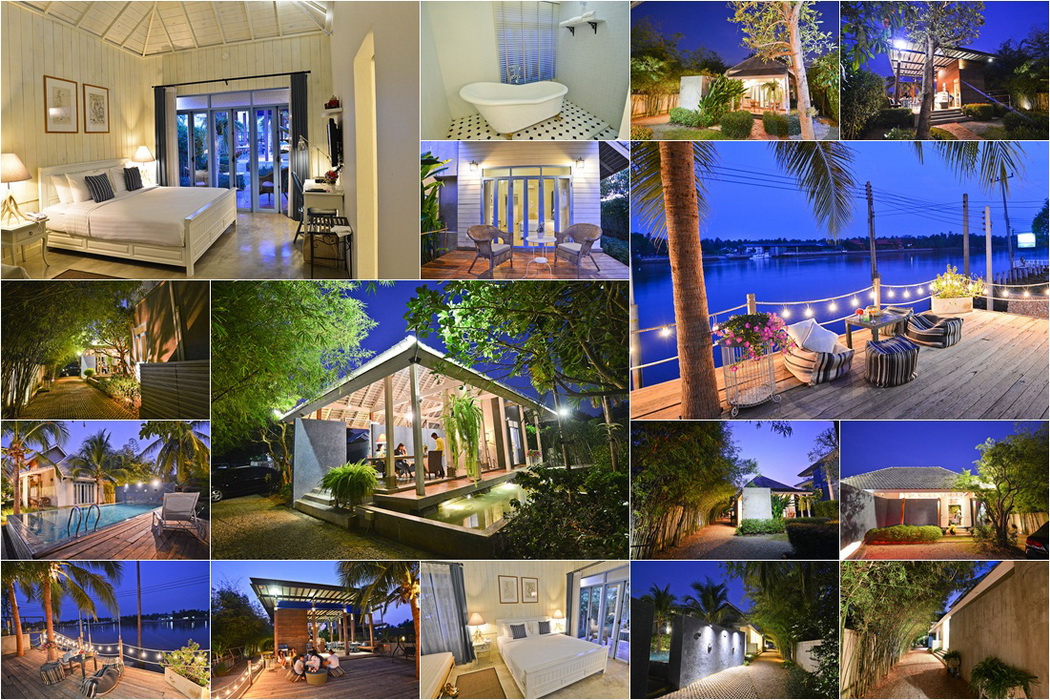.........This trip, we went to relax at Amphawa Floating Market on Wednesday, February 3rd. We stayed there for 1 night and it was our first time visiting Amphawa.
I've been wanting to come here for a long time, but I've heard that it's very crowded, with lots of traffic and difficulty finding parking. Plus, accommodation on weekends is expensive and always fully booked.
So I tried to stay on a weekday. So I booked a stay at this hotel, Pomelo Amphawa the Local Residence.
The hotel has only 6 rooms and is always fully booked on Saturdays, making it very difficult to book.
During this stay, we booked the cheapest standard room, but when we checked in, they recognized us as a fan reviewer and upgraded our room.
And the next day, the tourism authority of Samut Songkhram province came to take us on another trip, so I'd like to review this as an SR review.
The story in this episode will be as follows:
The Pomelo Amphawa the Local Residence where we stayed.
Boat trip to pay respects to 3 temples: Wat Chulamanee, Wat Kanoy, and Wat Bang Kung (Wat Phrong)
Kru Hom's Kitchen Restaurant
Fireflies boat tour
Palm Sugar Stove, Mit Preecha (Community Way of Life, Witnessing the Making of Palm Sugar)
Cycling in Bang Plab Community
R.2 Park
Leng Zab Noodle, Noodle for the Mighty
Umbrella Market
Let's take a look at how enjoyable Amphawa can be on a regular day. But one thing's for sure, there's no traffic, not many people, and it's really chill and relaxing.



If you like this review and want to tip me, please click the + button in the lower left corner.
Thank you.
Mom Pranom, we left Bangkok around 2 pm and arrived at the hotel.


Park the car and then check in.



After checking in, let's go to the room.



You can borrow a bicycle here to ride around.


Behind our room.

Let's go inside the room.

Free coffee and snacks are all gone.

The two cans of soda in the refrigerator are free.

Let's go check out the bathroom first.



Next, we move on to the bedroom. This room is still in pristine condition as it has only been open for about a year.





After packing our belongings and washing our faces, we will take a boat to pay respects to the Buddha and visit the Amphawa Floating Market by boat.

This boat, sir, departs from the pier in front of the hotel.

This uncle driver, he is both a guide explaining various stories to us, making us enjoy it.

The first temple that my uncle took us to.

Chulamanee Temple
Located on Highway 325 (Samut Songkhram-Bang Pae), kilometers 34-35, Bang Chang Subdistrict
It is an ancient temple on the banks of the Amphawa Canal, connected to the Phi Lok Canal.



This temple was built during the late Ayutthaya period, during the reign of King Prasat Thong.
It is believed that Thao Kaeo Phalik (Noi), the market master of Bang Chang, the founder of the Bang Chang Ratcha-iniku lineage, was the one who built it.
The area behind the old temple was the residence of Khun Nak (Queen Amarindra of the 1st reign) and Khun Bunrot (Queen Srisuriyendra of the 2nd reign).






Leaving the temple, the boatman took us on a detour to the Amphawa Floating Market. We were curious to see what it was like on a weekday.




Most of the shops are closed, but there are still some shops open for business.


The Westerner must be enjoying his meal.

And then we stopped by to pick up afternoon tea with my aunt.


The next place our uncle took us to was Wat Bang Kaen Noi.
The old man said that the floor of the ordination hall was paved with 7 large planks of teak wood, each 2 inches thick, 1 meter wide, and 14 meters long, which are no longer available today.



Bang Kaen Noi Temple
This temple was built during the reign of King Rama II in 1814. The ordination hall of this temple is very beautiful in terms of art.
Due to the intricate carving of teak wood on the interior walls and the exquisite decorations, as well as the art of embedding mokman wood to create beautiful images.
Khunying Chui (Noi) Vongsaroj built it in 1868.
The original ordination hall of the temple was built on a bamboo raft tied to a Bodhi tree on the banks of the Mae Klong River.
The temple has been well-maintained. Inside the ordination hall, the walls are made of carved teak wood depicting stories from the life of Buddha.
The birth, enlightenment, nirvana, and the ten Jataka tales are beautifully and clearly depicted by the craftsmanship of carvers from Phetchaburi province, which is famous for wood carving. It is considered a ubosot with beautiful wood carving art. For more information, please call 0 3476 1222.


This place is so beautiful. You have to see it with your own eyes.

The large wooden planks you mentioned.


Let's continue then.

And then the uncle took us to visit Bang Kung Temple (Bang Kung Camp).

History of Bang Kung Temple (Bang Kung Camp) Samut Songkhram
It is an ancient temple located in Bang Kung Subdistrict, Bang Khonthi District, Samut Songkhram Province.
According to history, it was built since the Ayutthaya period as an important temple.
Due to the fact that in the late Ayutthaya period, in the year 2308 BE, the Burmese army invaded and captured Ayutthaya.
King Ekathat ordered the southern provinces to send troops and ships to set up camp and build a wall around Bang Kung Temple in Bang Kung District, Samut Songkhram Province. This camp was called "Bang Kung Camp".

The Burmese army, which had marched along the Mae Klong River and invaded down to Bang Kung Camp, was unable to be resisted by the Ayutthaya army. Bang Kung Camp was therefore broken. After the Burmese captured Ayutthaya in 2310, Bang Kung Camp fell into a state of disrepair. When King Taksin the Great established Thonburi, he ordered the Chinese to gather and form a group of soldiers to guard the old camp at Bang Kung. It was therefore called another name, "Bang Kung Chinese Camp".

In 1768, about eight months after the fall of Ayutthaya, the Burmese army led by the governor of Tavoy marched down and surrounded the Chinese camp at Bang Kung. The Chinese soldiers who defended Bang Kung fought bravely but were outnumbered and nearly lost the camp to the Burmese.
The Samut Songkhram City Hall therefore sent a letter to Thonburi. King Taksin learned of this and led his army to attack the Burmese army, which was defeated. Later, in 1774, King Taksin the Great led a naval force to fight at Bang Kaew, Ratchaburi. During the journey, he stopped his army to rest and eat at Wat Klang Khai Bang Kung. The Fine Arts Department announced the registration of Wat Bang Kung as a national historic site in the Royal Gazette, Volume 113, Special Issue 50, on December 18, 1996.


Crossing the road to the other side will lead you to Wat Bang Kung, which is located by the Mae Klong River. In front of the temple, you can feed large silver barb fish and observe various other animals.



At Wat Bang Kung, there is another Unseen Thailand location: the Phothi Samphan Church.
This church was built during the Ayutthaya period. The locals call it "Luang Pho Dam Church". Its unique feature is that the entire church is covered by four types of trees: Bodhi tree, Banyan tree, Krai tree, and Grang tree. The locals call it the "Bodhi-covered Church".






Along the way, it's very beautiful, but it's not quite finished yet.



In the late afternoon, we relaxed at the hotel. The atmosphere by the water was very relaxing.
The price of drinks is also not expensive. And the hotel offers a free first drink.



We sat there until it got dark.



Let's take a look at the hotel's atmosphere at night. It's peaceful and romantic.





This is the front of our room.





And a riverside restaurant.

For dinner, we ate at a famous restaurant, Kru Hom Kitchen, which is right next to our hotel. So we could easily walk there and enjoy our meal.


This shop is recommended by Red Ink.


Can I see the menu please? The prices are great.





Let's take a look at the food.
This is called "Pla Too Sateeya", similar to "Pla Too Sam Ros".

A simple omelet, but it's delicious.

This crab paste chili dip is super spicy!

After we're full, let's take a boat to see the fireflies.


The old man took us to see the fireflies in different places for about an hour. It was a pity that no matter how we took pictures, we couldn't capture them.
And then my uncle took us to see the Amphawa Floating Market at night.
Which is really beautiful.





The highlight of waking up in Amphawa is the morning alms offering by the river.

Here, the monks rowed a boat to receive alms in front of the hotel.





After offering food to the monks, we had breakfast by the river.
Breakfast is included with the room booking.
The food is an American breakfast set.


After a hearty breakfast, we took the hotel's bicycles for a quick food tour.

And then we rode to see them make sugar at the Mitr Preecharn sugar mill, which is about 1 km from the hotel. We just followed the signs.
Come see how they make palm sugar from coconuts and buy some to take home. Their sugar is pure palm sugar with no additives.

We've arrived! They're in the middle of boiling the sugar. Here, they boil it twice a day, in the morning and evening, to coincide with the sugar cane harvest.

A container used to store sugar.


The ring on the pan is used to prevent the egg from overflowing.

After simmering until it thickens, the uncle will then stir it like this.
The uncle said that 7 liters of coconut sugar will yield 1 kilogram of palm sugar.


And then scoop it up and put it in a mold.

The sugar here does not contain preservatives. It is sold at 70 baht per kilogram.

The owner, Uncle, took us to see how to collect sugar.
Start by splitting the coconut shoot to allow it to flower, then cut the shoot and leave it for 5 days.

After 5 days, you can place a container under the sugar palm to collect the sap. One palm can produce 1.5 liters of sap per day, and one elephant can collect sap from 25 palms per day.

This is the sugar that has flowed out.


A newly developed dwarf variety of coconut palm. The old variety was much taller.

This is the one where they didn't cut off the trunk, so it came out as a normal fruit. The uncle cut it for me to try, and it turned out to be really sweet and fragrant.

I've been here for almost an hour. The old man is a great talker and he explained the process in a really fun way.
Come and visit us, friends.

In the morning, we checked out of the hotel. Ms. X from the Tourism Authority of Thailand (TAT) Samut Songkhram volunteered to take us on a tour.
He wants to take us cycling on a route he has created.

We have arrived at Bang Plab Community in Samut Songkhram, where they have laid out a cycling route to experience the exemplary community way of life, which is very interesting.

The pomelo from here, little Max guarantees that every single one is delicious. We bought some to try and it happened to be perfect for offering to the deities.

Let me grab a quick coffee before we go for a bike ride.

This is the TAT's bicycle that came to support. Anyone can pick it up and use it for free.

We're done choosing our bikes, let's go for a ride!

Various bases for us to visit along the way.



Let's stop here. Let's see how they make edible bitter melon.






Come and try it out.
Thanks to the villagers' wisdom, it doesn't taste bitter anymore. It's crispy, sweet, and delicious.

50 baht per box.

This is an ancient dessert. They say it's only available here.

This one tastes good too.

This is a pomelo tree. Let's take a look at the pomelo tree.



That's enough for now. The rest you have to come and experience yourself, otherwise it won't be fun. Then we'll go visit the Rama II Park together.
This park is a project to commemorate King Phra Phutthaloetla Naphalai of the Phra Phutthaloetla Naphalai Memorial Foundation under the Royal Patronage. It is a way to express gratitude for the beautiful art that he has bestowed upon the nation and has been recognized by the United Nations Educational, Scientific and Cultural Organization (UNESCO). Her Royal Highness Princess Maha Chakri Sirindhorn presided over the opening ceremony of the park on March 31, 1979, and it was opened to the public on June 1, 1987.

The Royal Pavilion Phra Buddha Lertla Naphalai
It is a Thai-style building with 4 buildings, covering an area of 600 square meters. It is an ethnological museum that displays artifacts from the early Rattanakosin period, reflecting the characteristics of art, culture, lifestyle, and livelihood of Thai people during the reign of King Phra Phutthaloetla Naphalai.


Thai dress rental services are also available.


The interior is very beautiful, but photography is not allowed.






We also stopped by the Amphawa Floating Market by land.

This is delicious. I tried it and it was good.


There are some souvenirs for sale.


This noodle vendor seems to be here every day. There are always a lot of people eating here.



This kind of atmosphere on weekends must be different.


And don't forget to stop by and buy some snacks with the beautiful girl.

At lunchtime, we told our younger brother that we wanted a restaurant that served delicious and famous single dishes, so that our friends could follow suit.
X from TAT took us to this restaurant for lunch. Spicy pork bone soup, powerful noodles, and authentic Hainanese chicken rice.



This is it, spicy pork bone soup in a big bowl, spicy and sour, only 90 baht.

And Hainanese chicken rice

Next up is the dessert that they told us we had to try.



And then come to pay respects to the Buddha before returning to the temple, Wat Phet Samut Worawihan or Wat Ban Laem, which is located near Mae Klong Railway Station.

Wat Phet Samut Worawihan, formerly known as Wat Ban Laem, was originally named Wat Si Champa.
Located in Mae Klong Subdistrict, Mueang Samut Songkhram District, Samut Songkhram Province, it is a royal monastery of the Worawihan level under the Maha Nikaya sect.

Built during the reign of King Prasat Thong of Ayutthaya

According to legend, in 1764, villagers from Laem in Phetchaburi fled the Burmese and settled in the area of Mae Klong Nuea, near Wat Sri Champa. They named their new village "Ban Laem" after their original village.
The villagers of Laem helped to renovate Wat Si Champa and renamed it Wat Ban Laem. Later, Wat Ban Laem was elevated to the status of a royal temple of the Worawihan class and was granted the name Wat Phet Samut Worawihan.

Biography of Luang Pho Ban Laem
Villagers from Laem District, Phetchaburi Province, went fishing with a cast net in the Mae Klong River, Samut Sakhon Province. They found two Buddha statues. One of them was a Buddha statue in the alms-carrying posture, which was invited to be enshrined at Wat Si Champa (currently known as Wat Ban Laem). This led the villagers to call this Buddha statue Luang Pho Ban Laem.
Since then, another Buddha statue in the meditation posture, which was brought back by the villagers of Laem District, Phetchaburi Province, has been enshrined at Wat Khao Takra, Phetchaburi Province.
The legend of the five Buddha statues floating on a raft down the Mae Klong River from a city north of Samut Sakhon Province. They are Luang Pho Wat Ban Laem, Luang Pho Sothon, Luang Pho To (Bang Phli), Luang Pho Wat Khao Takrao, and Luang Pho Wat Rai King. Villagers along the riverbank who had faith invited them to be enshrined as the principal Buddha images in the ordination hall of the temple for worship.
Wikipedia information



Leaving the temple, we walked to the Mae Klong Railway Station to see the Umbrella Market and buy some food before returning to Bangkok.
However, they are currently in the process of constructing and renovating the railway tracks, so there have been no trains running for a year. As a result, the market no longer needs to close during the day, until the trains start running again.






And then we walked along the train tracks to go shopping.






And that's it, a chill 24 hours on a normal day in Amphawa.
No need to jostle or compete for walking or eating. The accommodation is cheaper, the food doesn't have to wait long. Live a chill, comfortable and peaceful life by the river. I would like to tell my friends to try to come and visit on weekdays.

And that's it! I hope you enjoyed it.
Finally,
Thank you Pantip for the great platform that allows us to share information and find good information for independent travel.
Thank you, Nong X, from the Tourism Authority of Samut Songkhram, for taking us on a sightseeing tour. What do you have for our friends to see?
Thank you to all my friends and fans who have always supported Maen Prathom.
I will try to make better reviews, better, okay?
Mom Pranom
Love all readers..........................................
Mom Pranom, you see.
แม่ประนอม
Friday, September 27, 2024 9:56 AM















